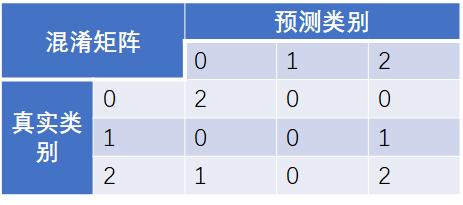一、分类评估指标
- 准确率(最直白的指标)
缺点:受采样影响极大,比如100个样本中有99个为正例,所以即使模型很无脑地预测全部样本为正例,依然有99%的正确率
适用范围:二分类(准确率);二分类、多分类(平均准确率)
from sklearn.metrics import accuracy_score y_pred = [0, 2, 1, 3] y_true = [0, 1, 2, 3] accuracy_score(y_true, y_pred) 0.5 accuracy_score(y_true, y_pred, normalize=False) 2
from sklearn.metrics import balanced_accuracy_score y_true = [0, 1, 0, 0, 1, 0] y_pred = [0, 1, 0, 0, 0, 1] balanced_accuracy_score(y_true, y_pred) 0.625
- 混淆矩阵
适用范围:所有分类模型,包括二分类、多分类
介绍:实质是一张交叉表,纵轴为真实值,横轴为预测值
API介绍:
Example1:多分类任务,类别已经转换为整数类型,分别为0,1,2三个类别from sklearn.metrics import confusion_matrix
y_true = [2, 0, 2, 2, 0, 1] y_pred = [0, 0, 2, 2, 0, 2] confusion_matrix(y_true, y_pred) array([[2, 0, 0], [0, 0, 1], [1, 0, 2]])
可以推导出混淆矩阵如下所示

Example2:多分类任务,类别没有转换为整型数值,而是作为字符串直接传入from sklearn.metrics import confusion_matrix
y_true = ["cat", "ant", "cat", "cat", "ant", "bird"] y_pred = ["ant", "ant", "cat", "cat", "ant", "cat"] confusion_matrix(y_true, y_pred, labels=["ant", "bird", "cat"]) array([[2, 0, 0], [0, 0, 1], [1, 0, 2]])证明该API可以直接传入类别型字符串,混淆矩阵如下所示

Example3:二分类任务from sklearn.metrics import confusion_matrix confusion_matrix([0, 1, 0, 1], [1, 1, 1, 0]) array([[0, 2], [1, 1]], dtype=int64) tn, fp, fn, tp = confusion_matrix([0, 1, 0, 1], [1, 1, 1, 0]).ravel() (tn, fp, fn, tp) (0, 2, 1, 1)

此处“1”为正例,“0”为反例 -
Roc曲线及auc值
适用范围:二分类
介绍:roc曲线为二维平面的一条曲线,横坐标为fpr,纵坐标为tpr,auc(area under the curve)顾名思义,即为曲线与横轴围成的曲线下的面积
API:
sklearn中有三个关于roc计算相关的接口,分别为1 metrics.roc_auc_score() 2 metrics.roc_curve() 3 metrics.auc()
1)直接计算auc的值
from sklearn import metrics import numpy as np
y_true = np.array([0, 0, 1, 1]) y_scores = np.array([0.1, 0.4, 0.35, 0.8]) metrics.roc_auc_score(y_true, y_scores) 0.752)先计算fpr,tpr以及threshold(阈值),再通过fpr和tpr求auc
from sklearn import metrics import numpy as np y_true = np.array([0, 0, 1, 1]) y_scores = np.array([0.1, 0.4, 0.35, 0.8]) fpr, tpr, threshold = metrics.roc_curve(y_true, y_scores) (fpr, tpr, threshold) (array([0. , 0.5, 0.5, 1. ]), array([0.5, 0.5, 1. , 1. ]), array([0.8 , 0.4 , 0.35, 0.1 ])) metrics.auc(fpr, tpr) 0.75
注意接口接收的参数为类别的真实标签以及模型输出的概率(得分)值,而非模型预测的标签(标签需要通过概率+阈值来得到)
- PR曲线及F1-score
PR曲线为二维平面曲线,横轴为Recall(召回率),纵轴为Precision(精确率),F1-score为recall和precision的调和平均数
适用范围:二分类
API:
sklearn中有五个常用的与PR相关的接口
1 metrics.precision_recall_curve() 2 metrics.precision_recall_fscore_support() 3 metrics.precision_score() 4 metrics.recall_score() 5 metrics.fbeta_score()
1)计算pr曲线
接口接收两个参数,其一为样本的真实值,另一个为样本的预测概率(得分),示例如下:import numpy as np from sklearn.metrics import precision_recall_curve y_true = np.array([0, 0, 1, 1]) y_scores = np.array([0.1, 0.4, 0.35, 0.8]) precision, recall, thresholds = precision_recall_curve(y_true, y_scores) precision, recall, thresholds (array([0.66666667, 0.5 , 1. , 1. ]), array([1. , 0.5, 0.5, 0. ]), array([0.35, 0.4 , 0.8 ]))
2)计算当预测值已经通过阈值转化为类别后的具体某一阈值下的PR及F-score值
from sklearn import metrics #该函数可直接求出precision、recall和f-score
precision,recall,fbeta_score,support = metrics.precision_recall_fscore_support()#以下三个函数可分别求出precision、recall和f-score
precision = metrics.precision_score()recall = metrics.recall_score()f-score = metrics.fbeta_score() - ks曲线及ks值
适用范围:二分类
ks曲线的横坐标为阈值的分位数,纵坐标分别为tpr,fpr,ks值(tpr-fpr),所以可用2中与ROC相关的接口计算得出 - kappa系数、汉明损失、铰链损失、杰卡德相关系数
适用范围:多分类
1 metrics.cohen_kappa_score() 2 metrics.hamming_loss() 3 metrics.hinge_loss() 4 metrics.jaccard_score() 5 metrics.log_loss()
- 马修斯相关系数(MCC)
适用范围:二分类
from sklearn.metrics import matthews_corrcoef y_true = [+1, +1, +1, -1] y_pred = [+1, -1, +1, +1] matthews_corrcoef(y_true, y_pred) -0.33333333
二、回归评估指标
- R2
- MSE
- MAE
睡了。。。明天再修改